Multiple Choice
Identify the
choice that best completes the statement or answers the question.
|
|
|
Are there some goods that you would
always find money to
buy, even if the
price were to rise drastically? Are there
other goods that you would cut back
on, or
even stop buying altogether, if the price
were to rise just slightly?
Economists
describe the way that
consumers respond to price changes as
elasticity of demand. Elasticity of
demand
dictates how drastically buyers will cut
back or increase their demand for a
good
| when the price rises or falls, respectively.
Your demand for a good that
you will keep
buying despite a price increase is inelastic,
or relatively unresponsive to price changes.
In the second
example, in which you buy
much less of a good after a small price
increase, your demand is
elastic. A
consumer with highly elastic demand for a
good is very responsive to price
changes. | | |
|
|
|
1.
|
You are a diabetic and take
medication daily. You notice that they have changed the price of your medication. Even though it may
make you angry, you must buy the medication because you need it for your illness. In this example
your demand for the diabetic medication is
a. | elastic | c. | both elastic and
inelastic | b. | inelastic | d. | flexible |
|
|
|
2.
|
You own a small doughnut shop
and notice that your suppliers have raised the price of sugar. In this example what do you predict
your demand will be for sugar.
a. | elastic | c. | revenue elastic | b. | inelastic | d. | none of these |
|
|
|
3.
|
You take your girl friend to
the movies. You notice that they have raised the price of gummy bears and lowered the price of
m&m’s. You decide to buy your girl friend m&m’s. Your demand is
a. | elastic | c. | cheap | b. | inelastic | d. | lower |
|
|
|
Calculating
Elasticity
To compute
elasticity of demand, take the percentage change in the demand of a good, and divide this number by
the percentage change in the price of the good. You can find the equation for elasticity in Figure
4.7 on page 92. The law of demand implies that the result will always be negative. This is because an
increase in the price of a good will always decrease the quantity demanded, and a decrease in the
price of a good will always increase the quantity demanded. For the sake of simplicity, economists
drop the negative sign
PERCENTAGE CHANGE IN THE PRICE OF A
GOOD
PERCENTAGE CHANGE IN DEMAND OF A GOOD.
|
|
|
4.
|
The formula above is used
to
a. | find the elasticity of
demand | c. | find the cost in
percentage | b. | find the price in percentage | d. | calculate price |
|
|
|
Calculating
Elasticity
Price
Range
The elasticity of demand
for a good varies
at every price level. Demand for a good can
be highly elastic at one price
and inelastic
at a different price. For example, demand for a glossy magazine will be inelastic
when
the price rises 50 percent from 20 cents to
30 cents. The price is still very low,
and
people will buy almost as many copies as
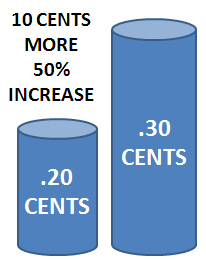
Magazine A
|
they did before. However, when the
price
increases 50 percent from $4.00 to $6.00,
demand will be much more elastic.
Many
readers will refuse to pay $2.00 more for
the magazine. Yet in percentage terms, the
change in the
magazine’s price is exactly
the same as when the price rose from 20
cents to 30
cents.
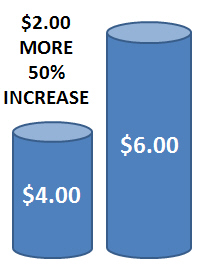
Magazine B | | |
|
|
|
5.
|
Which statement is true about
elasticity of demand and price range?
a. | The same percentage change in price
at all levels will effect elasticity the same. | c. | Elasticity may change at different price levels though percentage change
remains the same. | b. | Change in price has no effect on elasticity of
demand | d. | Real dollar changes and percentage changes are always the
same. |
|
|
|
6.
|
Which magazine above is likely
to be most inelastic?
a. | Magazine
A | c. | Both have the same
elasticity | b. | Magazine B | d. | Both have the same inelasticity |
|
|
|
7.
|
Which magazine above is likely
to be most elastic?
a. | Magazine
A | c. | Both have the same
elasticity | b. | Magazine B | d. | Both have the same inelasticity |
|
|
|
Calculating
ElasticityValues of
Elasticity
We have been using
the terms inelastic
and
elastic to describe consumers’ responses to
price changes. These terms
have precise
mathematical definitions. If the elasticity of
demand for a good at a certain
price is less
than 1, we describe demand as inelastic. If
the elasticity is greater
than one, demand is
elastic. If elasticity is exactly equal to 1, we
describe demand as
unitary elastic.
When elasticity of demand is unitary, the
percentage change in
quantity demanded is
exactly equal to the percentage change in
the price. Suppose the
elasticity of demand
for a magazine at $2 is unitary. When the
price of the magazine rises by
50 percent to
$3, the newsstand will sell exactly half as
many copies as before.
Think
back to Ashley’s demand schedule
for pizza in Section 1. Ashley’s demand
schedule
shows that if the price per slice
were to rise from $1.00 to $1.50, her
quantity demanded would
fall from 4 slices
to 3 slices per day. The change in price
| from $1.00 to
$1.50 is a 50 percent
increase. The change in quantity demanded
from 4 to 3 slices is a 25
percent decrease.
Dividing the 25 percent decrease in
quantity demanded by the 50
percent
increase in price gives us an elasticity of
demand of 0.5.
Since Ashley’s
elasticity of demand at
prices of $1.00 to $1.50 is less than 1, we
say that Ashley? ’s
demand for pizza is
inelastic. In other words, a price increase
has a relatively small effect
on the number
of slices of pizza she buys.
Suppose that we survey another
customer and
find that, when the price of
pizza rises by 40 percent, this person’s
quantity demanded
falls by 60 percent.
The change in the quantity demanded of
60 percent is divided by the change
in
price of 40 percent, equaling an elasticity
of demand of 1.5 (60 percent/40 percent
=
1.5). Since this result is greater than 1, this
customer’s demand is elastic. In
other
words, this customer is very sensitive to
changes in the price of
pizza. | | |
|
|
|
8.
|
If the change in elasticity is
less than 1, elasticity is said to be
a. | elastic | c. | unitary | b. | inelastic | d. | the same |
|
|
|
9.
|
If the change in elasticity is
greater than 1, elasticity is said to be
a. | elastic | c. | unitary | b. | inelastic | d. | the same |
|
|
|
10.
|
When elasticity of demand is
__________, the percentage change in quantity demanded is exactly equal to the percentage change in
the price
a. | elastic | c. | unitary | b. | inelastic | d. | a percentage |
|
|
|
11.
|
How do we calculate the
elasticity of demand
a. | Divide the percent increase in
quantity demanded by the percent increase in price | c. | Divide the quantity demanded by the increase in price
| b. | Divide the percent decrease in
quantity demanded by the percent decrease in price | d. | Divide the percent decrease in quantity demanded by the percent increase in
price |
|
|
|
Factors Affecting
Elasticity
Why is the demand
for some goods so much less elastic than for other goods? Rephrase the question and ask yourself,
“What is essential to me? What goods must I have, even if the price rises greatly” The
goods you list might have some traits that set them apart from other goods and make your demand for
those goods less elastic. Several different factors can affect a person’s elasticity of demand
for a specific good. Availability of
Substitutes
If there are
few substitutes for a good, then
even when its price rises greatly, you might
still buy it. You
feel you have no good alternatives. For example, if your favorite musical group plans to give a
concert, and you want to attend, there really is no substitute for a ticket. You could go to a
concert to hear some other band, but that would not be as good. You’ve got to have tickets for
this concert, and nothing else will do. Under these circumstances, a moderate change in price is not
going to change your mind. Your demand is inelastic.
| Similarly, demand for life-saving medicine
is usually inelastic. For many prescription drugs, the only possible substitute is to try an unproven
treatment. For this reason, people with an illness will continue to buy as much needed medicine as
they can afford, even when the price goes up.
If the lack of substitutes can make demand
inelastic, a wide choice of substitute goods can make demand elastic. The demand for a particular
brand of apple juice is probably elastic because people can choose from dozens of good substitutes if
the price of their preferred brand rises. | | |
|
|
|
12.
|
What is the main idea of the
paragraph above, “Factors Affecting Elasticity?”
a. | Elasticity of demand is the same for
all products | c. | Only the demand
for medicine is inelastic | b. | Why is there no difference in the elasticity of demand for
products? | d. | There are many reasons for the
elasticity of demand for certain products |
|
|
|
13.
|
If there are only a few
substitutes for a product, what will be the effect on demand for that product?
a. | More
inelastic | c. | No
effect | b. | More elastic | d. | More elastic and more inelastic |
|
|
|
14.
|
When Mr. Schneemann was a young
man many girls wanted to date him. From Mr. Schneemann’s point of view the demand for girls was
_____ while the girl’s demand for Mr. Schneemann was _____
a. | elastic -
elastic | c. | elastic -
inelastic | b. | inelastic - inelastic | d. | inelastic - elastic |
|
|
|
Factors Affecting
Elasticity
Relative
Importance
A second
factor in determining a good’s
elasticity of demand is how much of your
budget you spend
on the good. If you
already spend a large share of your income
on a good, a price increase will
force you to
make some tough choices. Unless you want
to cut back drastically on the other
goods
in your budget, you must reduce consumption
of that good by a significant amount
to
keep your budget under control. The
higher the jump in price, the more you will
have to
adjust your purchases.
If you currently spend half of your
budget on clothes, then even a
modest
increase in the cost of clothing will
probably cause a large reduction in
the
quantity you purchase. In other words,
your demand will be elastic.
However, if the
price of shoelaces
doubled, would you cut back on your
shoelace purchases? Probably not.
You
may not even notice the difference. Even if
you spend twice as much on shoelaces,
they
will still account for only a tiny part of
your overall budget. Your demand
for
shoelaces is inelastic. | Necessities Versus
Luxuries
The third
factor in determining a good’s
elasticity varies a great deal from person to
person, but
it is nonetheless important.
Whether a person considers a good to be a
necessity or a luxury
has a great impact on
the good’s elasticity of demand for that
person. A necessity is a
good people will
always buy, even when the price increases.
Parents often regard milk as a
necessity.
They will buy it at any reasonable price. If
the price of a gallon of milk rises
from
$2.49 to $4.49, they will still buy as much
milk as their children need to stay
healthy.
Their demand for milk is inelastic.
The same parents may regard steak as
a
luxury. When the price of steak increases
by a little bit, say 20 percent, parents may
cut
their monthly purchases of steak by
more than 20 percent, or skip steak altogether.
Steak
is a luxury, and consumers
can easily reduce the quantity they
consume. Because it is easy to
reduce the
quantity of luxuries demanded, demand is
elastic. | | |
|
|
|
15.
|
Which statement below is true
regarding demand?
a. | If you spend a large part of your
income on a product, the demand for that product is most likely elastic | c. | The portion of your income you spend on a product
indicates nothing about demand | b. | If you spend a large part of your income on a product, the demand for that
product is most likely inelastic | d. | Demand and money are not related but they are elastic when they are
inelastic |
|
|
|
16.
|
There are many substitutes for
a cell phone; cordless phones, home phones, computers, public phones, pagers, etc..The demand for
cell phones for most teenagers is
a. | elastic | c. | neither elastic nor
inelastic | b. | inelastic | d. | not important |
|
|
|
17.
|
You want your boyfriend to take
you to Cheesecake Factory for dinner but he wants to take you to McDonalds. Most likely your
boyfriends love for you is
a. | elastic | c. | both elastic and
inelastic | b. | inelastic | d. | neither elastic nor inelastic |
|
|
|
Factors Affecting
Elasticity
Change over Time
When a price changes, consumers often
need time to
change their shopping habits.
Consumers do not always react quickly to
a price increase because
it takes time to find
substitutes. Because they cannot respond
quickly to price changes, their
demand is
inelastic in the short term. Demand sometimes becomes more elastic over
time,
however, because people can eventually
find substitutes that allow large
adjustments
to what they buy.
Consider the example of gasoline. When
a person purchases
a vehicle, he or she
might choose a large vehicle that requires a
greater volume of gasoline
per mile to run.
This same person might work at a job many miles away from home and shop at
a
supermarket that is far from both work
and home. These factors determine how
much gasoline
this person demands, and
none can be changed easily.
In the early 1970s, several oil-rich
countries
cut their oil exports to the United States, and gasoline prices rose quickly. In the
short run, there was very little that people could do to reduce their consumption of gasoline. They
still needed to drive to school and work. At first, drivers were more likely to pay more for the same
amount of gasoline than they were to buy fuel-efficient cars or move closer to their schools and
workplaces.
|
However, because gas prices stayed high
for a considerable period of
time, some
people eventually switched to more fuel efficient cars. Others formed car
pools,
walked or rode bicycles, and used public
transportation. In the long run,
people
reduced their consumption of gasoline by
finding substitutes. Demand for
gasoline,
inelastic in the short term, is more elastic in
the long term.
As another
example, consider what
happened to gasoline prices from the early
1980s through the early
2000s. Adjusting
for inflation, the price of a gallon of gas fell considerably from its highs in
the 1970s. In
addition, gasoline prices remained low for
many years. At first, people continued
to
seek out fuel-efficient cars. Over time,
however, many Americans switched back
to larger
vehicles that get fewer miles to the
gallon. Because the price of gas remained
low, people
gradually adjusted their habits
to use more and more gasoline. Just as
demand for gasoline
responded slowly to
an increase in price, it also responded
slowly to a decrease in
price.
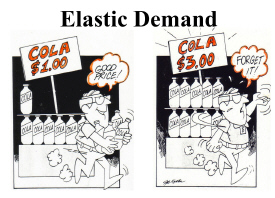 | | |
|
|
|
18.
|
What effect does time have on
the elasticity of demand?
a. | It becomes more inelastic as time
goes by | c. | Elasticity is not
affected by time | b. | It becomes more elastic as time goes by | d. | There is no demand for workers who are always on time because they are
elastic |
|
|
|
19.
|
In the cartoon above demand for
Cola is inelastic. What will happen over time as the buyer has time to look for other drink products
to substitute for the cola?
a. | Demand for drinks will become more
elastic | c. | He will demand
that they lower cola prices | b. | Demand for drinks will become more inelastic | d. | Demand will be neither elastic nor
inelastic |
|
|
|
Elasticity and
Revenue
Elasticity is important
to the study of economics because elasticity helps us measure how consumers respond to price changes
for different products. Elasticity is also an important tool for business planners like the pizzeria
owner described in Sections 1 and 2. The elasticity of demand determines how a change in prices will
affect a firm’s total revenue or income.
Computing a Firm? ’s Total Revenue
A company’s total revenue is defined as the
amount of money the company receives by
selling its goods. This is determined by two factors: the
price of the goods and the quantity sold. If a pizzeria sells 125 slices of pizza per day at $2.00
per slice, total revenue would be $250 per day.
|
|
|
20.
|
Which statement below is
true?
a. | Price is the only thing that effects
demand | c. | Elasticity does not indicate much
about prices and profits | b. | The demand for elasticity equals the supply of elasticity for a product over
time. | d. | Elasticity of demand can help a business person by showing
how income and prices can effect his business |
|
|
|
21.
|
Look at the chart above.
Setting the price too high or too low
a. | has no effect business
income | c. | can effect demand and
profits | b. | can effect demand but not profits | d. | is not very important to small business
persons |
|
|
|
22.
|
Look at the chart above. If you
raise the price of a slice of pizza from .50 to $3.00, what will the total revenue
be?
a. | $1.50 | c. | $3.00 | b. | $2.50 | d. | $1,00 |
|
|
|
23.
|
If you owned the pizza shop
above, what would you set the price of a slice of pizza to realize the most
profit?
a. | .50 | c. | $2.00 | b. | $1.50 | d. | $3.00 |
|
|
|
Elasticity and Revenue
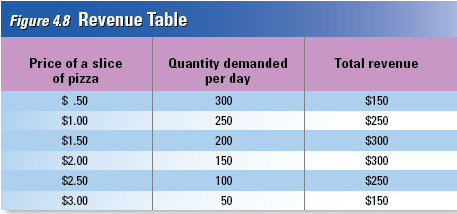
Total
Revenue and Elastic Demand
The law of demand tells us that an increase
in price will decrease the
quantity
demanded. When a good has an elastic
demand, raising the price of each unit sold
by
20 percent will decrease the quantity
sold by a larger percentage, say 50 percent.
The quantity
sold will drop enough to
actually reduce the firm’s total revenue.
Figure 4.8,
drawn from the demand curve
for the pizzeria, shows how this can
happen. An increase in price
from $2.50 to
$3.00, or 20 percent, decreases the
quantity sold from 100 to 50, or
50
percent. As a result, total revenue drops
from $250 to $150.
The same process can
also work in
reverse. If the firm were to reduce the price
by a certain percentage, the
quantity
demanded could rise by an even greater
percentage. In this case, total
revenues
could rise.
| It may surprise you that a firm could
lose revenue by
raising the price of its
goods. But if the pizzeria started selling
pizza at $10 a slice, it
would not stay in
business very long. Remember that elastic
demand comes from one or more of
these
factors:
1.
availability of substitute goods
2. a limited budget that does not allow
price
changes
3. the perception of the good as a
luxury item
If these conditions are
present, then the
demand for the good is elastic, and a firm
may find that a price increase
reduces its
total revenue.
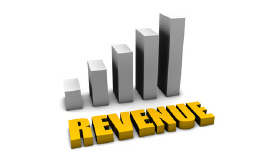 | | |
|
|
|
24.
|
What can happen to the total
revenue of a business if prices are raised too much?
a. | total revenue may
fall | c. | total revenue will always
increase | b. | total revenue is usually not affected | d. | total revenue will always
decrease |
|
|
|
25.
|
Which of the following does
not effect the elasticity of
demand?
a. | too little money to spend of
goods | c. | availability of substitute
goods | b. | viewing a good as a luxury rather than something that is
needed | d. | central planners who fix the price and supply of
products |
|
|
|
26.
|
A business could loose money by
raising prices
|
|
|
Elasticity and Revenue
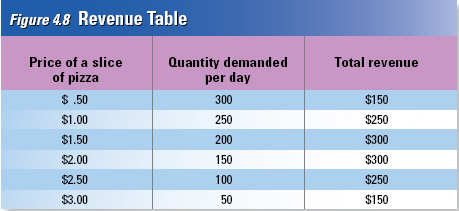
Total
Revenue and Inelastic Demand
Remember that if demand is inelastic,
consumers’ demand is not very
responsive
to price changes. Thus, if the firm raises its
price by 25 percent, the quantity
demanded
will fall, but by less than 25 percent. The
firm will have greater total revenues.
In
other words, the higher price makes up for
the firm’s lower sales, and the firm brings
in
more money.
On the other hand, a decrease in price
will lead to an increase in the
quantity
demanded if demand is inelastic. However,
demand will not rise as much, in
percentage
terms, as the price fell, and the firm’s total
revenue will
decrease. | Elasticity and Pricing
Policies
Because of
these relationships, a firm needs
to know whether the demand for its
product is elastic or
inelastic at a given
price. This knowledge helps the firm make
pricing decisions that lead to
the greatest
revenue. If a firm knows that the demand
for its product is elastic at the
current
price, it knows that an increase in price
would reduce total revenues. On the
other
hand, if a firm knows that the demand for
its product is inelastic at its current price,
it
knows that an increase in price will
increase total revenue. In the next chapter,
you
will read more about the choices
producers make to reach an ideal level
of
revenue. | | |
|
|
|
27.
|
What is total
revenue?
a. | the total amount of money that at
business takes in | c. | the total losses
of a company | b. | the total profits of a company | d. | the total losses on a product |
|
|
|
28.
|
If a company raises prices and
there is no change in the demand for its products, demand is
a. | elastic | c. | increased | b. | inelastic | d. | decreased |
|
|
|
29.
|
Knowing whether the demand for
its product is elastic or inelastic at a given price helps the firm make pricing decisions that lead
to
a. | greater
income | c. | increased
expenditures | b. | less income | d. | decreased expenditures |
|
|
|
|
|
|
30.
|
Price goes down and revenue
goes down
a. | elastic
demand | b. | inelastic
demand |
|
|
|
31.
|
Price increases and total
revenue goes down
a. | elastic
demand | b. | inelastic
demand |
|
|
|
32.
|
Lower prices and a rise in
total revenue
a. | elastic
demand | b. | inelastic
demand |
|
|
|
33.
|
Price increases and revenue
increases
a. | elastic
demand | b. | inelastic
demand |
|
|
|
34.
|
If the price of a slice of
pizza is $1.50 and I raise it 100%, what will be the percentage change in total
revenue?
a. | 50%
more | c. | 100%
more | b. | 50% less | d. | 100% less |
|
Multiple Response
Identify one
or more choices that best complete the statement or answer the question.
|
|
|
Calculating
Elasticity
To compute
elasticity of demand, take the percentage change in the demand of a good, and divide this number by
the percentage change in the price of the good. You can find the equation for elasticity in Figure
4.7 on page 92. The law of demand implies that the result will always be negative. This is because an
increase in the price of a good will always decrease the quantity demanded, and a decrease in the
price of a good will always increase the quantity demanded. For the sake of simplicity, economists
drop the negative sign
PERCENTAGE CHANGE IN THE PRICE OF A
GOOD
PERCENTAGE CHANGE IN DEMAND OF A GOOD.
|
|
|
35.
|
Why does the law of demand
implies that the result will always be negative? (pick 2)
|
Short Answer
|
|
|
|
|
|
36.
|
Examine the graphic above.
Study the goals. Explain what you expect to learn in this lesson. Also, study the vocabulary words
and look for them as you proceed through this lesson. You will be quizzed on them
later.
|